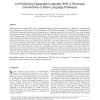Free Online Productivity Tools
i2Speak
i2Symbol
i2OCR
iTex2Img
iWeb2Print
iWeb2Shot
i2Type
iPdf2Split
iPdf2Merge
i2Bopomofo
i2Arabic
i2Style
i2Image
i2PDF
iLatex2Rtf
Sci2ools
BRAIN
2015
Springer
2015
Springer
L2-Proficiency-Dependent Laterality Shift in Structural Connectivity of Brain Language Pathways
Diffusion tensor imaging (DTI) and a longitudinal language learning approach were applied to investigate the relationship between the achieved second language (L2) proficiency during L2 learning and the reorganization of structural connectivity between core language areas. Language proficiency tests and DTI scans were obtained from German students before and after they completed an intensive 6-week course of the Dutch language. In the initial learning stage, with increasing L2 proficiency, the hemispheric dominance of the Brodmann area (BA) 6temporal pathway (mainly along the arcuate fasciculus) shifted from the left to the right hemisphere. With further increased proficiency, however, lateralization dominance was again found in the left BA6-temporal pathway. This result is consistent with reports in the literature that imply a stronger involvement of the right hemisphere in L2 processing especially for less proficient L2 speakers. This is the first time that an L2 proficiency-...
| Added | 17 Apr 2016 |
| Updated | 17 Apr 2016 |
| Type | Journal |
| Year | 2015 |
| Where | BRAIN |
| Authors | Huadong Xiang, Tessa Marije van Leeuwen, Dan Dediu, Leah Roberts, David G. Norris, Peter Hagoort |
Comments (0)

